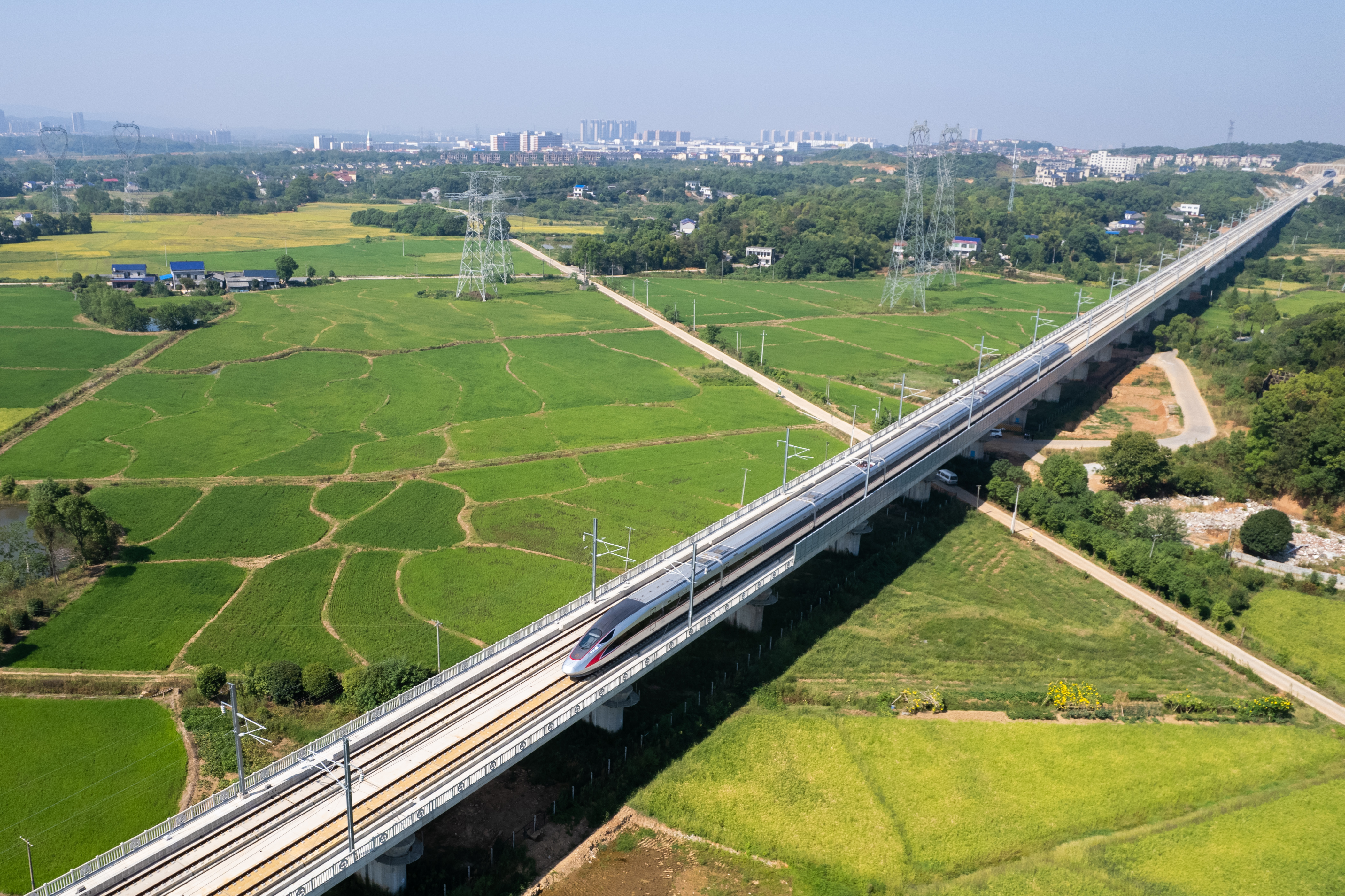China's High-speed Rail Makes Monumental Advances
A bullet train runs along the high-speed railway in Changsha, Hunan province. (PHOTO: XINHUA)
By WANG Xiaoxia
China's high -speed rail (HSR) has undergone a process from acquisition, adoption and re -innovation to independent innovation and now China has risen to be the world leader in HSR technology.
From over 9,000 km in 2012 to more than 40,000 km at present, China's HSR tops the world in terms of the operating length of HSR, projects scale under construction, the number of electric multiple unit (EMU) trains in operation and the speed of commercial operation in the world.
Independent innovation in HSR technology
In the past decade, China developed an advanced HSR technology system with independent intellectual property rights, covering the three major fields including equipment manufacturing, project construction and operation management.
The Fuxing bullet train was rolled out in September 2017. The train, which contains more than 2,500 sensors to simultaneously collect some 1,500 real-time indicators from all carriages, was the result of five year's effort from more than 30 institutes and companies, said Zhang Bo, researcher at the China Academy of Railway Sciences.
The sheer size of China and its diversity of terrain, geology and climate have presented the country's engineers with incredible challenges, pushing them to break bottlenecks and achieve technological breakthroughs.
Fuxing bullet trains are being continuously upgraded to be faster, safer, greener and more intelligent. On April 21, the train reached a world record-breaking relative speed at 870 km/h on the Puyang-Zhengzhou section of Jinan-Zhengzhou HSR.
New technology such as autonomous train operation has also been introduced. The driverless bullet trains connecting Beijing and Zhangjiakou in Hebei province can reach a speed up to 350 km/h, making them the world's fastest autonomous trains.
After a decade's demonstration, China's HSR technology was well received around the world and was adopted in overseas projects, such as the Jakarta -Bandung HSR and the China-Laos Railway.
Wider railway network boosts regional development
The HSR construction in China has made rapid progress since 2008, when the first Beijing-Tianjin intercity railway with a designed speed of 350 km/h was put into operation. Since 2012, a large number of HSRs have been put into operation, with an annual rail line increase of 3,500 kilometers. To date, the HSR lines has connected 93 percent of cities with a population of 500,000 or more, boosting regional development.
Gaoyou, a city located in Jiangsu province, had no railway until the end of 2020, when Lianyungang-Zhenjiang HSR was opened to traffic, integrating the town into the fast-track development of Yangtze River Delta region.
Wufushan HSR station in Jiangxi has brought new life to mountainous towns. The traveling time in the area has shortened considerably, and the local national forest park and other tourist spots become more accessible.
In the past decade, more than 20,000 kilometers of HSR lines have been built in rural areas and poverty-stricken areas, accounting for 80 percent of the country's total during the same period, allowing all Chinese people to benefit from the growth.
Upgraded operation for better services
Efficiency, convenience and intelligence are the goals of modern transportation. Along with rapid expansion, China's HSR has upgraded its operation to provide better services for passengers and cargo.
12306.cn, China's official website for purchasing railway tickets, is the world's largest of its kind. By April 2020, electronic tickets were available for all HSR and intercity railways on China's mainland, requiring only an ID card to get onboard.
Fengtai Railway Station, built in 1895, reopened as the largest rail transport hub in Asia on June 20, 2022 after four year's renovation work. The station occupies 400,000 square meters and is able to host 14,000 passengers per hour at its peak, operating bullet and regular trains as well as subway lines.
"It's hard not to be impressed by the sheer size of some of the new stations, and by the efficiency with which the system moves vast numbers of people, all with a reserved seat and without the need for paper tickets," said Mark Smith, founder of the Man in Seat Sixty-One.
In 2021, China State Railway Group has upgraded the e -commerce platform to realize 24/7 online processing of railway freight business. More than 6,900 enterprises have registered on the platform, and 97 percent of waybills have been digitalized, which effectively improves the efficiency of freight business and its smooth operation during the pandemic.



